
Users of SAP ERP 6.0 are on a count down. In 2025, SAP will cease to support its current Business Suite ERP systems as by then, it expects everyone to have transitioned to its next generation ERP platform, SAP S/4HANA.
SAP says S/4HANA is its response to the increasing complexity and real-time nature of today’s digital world. It offers real-time data access, enabling businesses to react more quickly to market and business changes. It simplifies business functions, data structure, user experience, and analysis to help businesses benefit from the likes of interoperability, the Internet of Things, and Big Data.
2025 might seem like it’s a long way off and smaller organisations may be able to wait for a good reason to make the move. But large organisations that have been using SAP for years and for whom it is the core of the business’ functions, need to be thinking about planning their move now as it’s far more than a straight forward upgrade.
It is in fact a change management challenge for the whole business as the new platform enables different ways of working and organisations will have to evaluate and adapt their existing business processes.
The state of migration to SAP S/4HANA
We spoke to over 130 SAP customers globally to understand where they are at in their migration journeys and they told us:
- 28% have no plans to move to SAP S/4HANA in the short term
- 17% are involved in projects to move from SAP ECC to the new ERP platform
- Just 9% are in the process of implementing S/4HANA for the first time
- And 45% plan to make the move in the next two years.
It’s clear that businesses are all at different stages of their migration journeys. And, in our experience many SAP professionals are confused about the different deployment options available to them and the impact the move will have on their operations.
How well do you really know your competitors?
Access the most comprehensive Company Profiles on the market, powered by GlobalData. Save hours of research. Gain competitive edge.

Thank you!
Your download email will arrive shortly
Not ready to buy yet? Download a free sample
We are confident about the unique quality of our Company Profiles. However, we want you to make the most beneficial decision for your business, so we offer a free sample that you can download by submitting the below form
By GlobalDataKey deployment considerations
If you’re at the start your journey, there’s lots to consider when deciding on the correct deployment method for your business:
- What’s the end goal for the new platform? It’s important to understand your business objectives before migrating as it will only be a success if it fits with future plans for the business. It’s important to understand how the new platform will add value to your business.
- What does your current ERP landscape look like? Is SAP invaluable to the running of your business and something that would be difficult to replace?
- What is the quality of the data in the source system? To take full advantage of the real-time analytics offered by S/4HANA, you can no longer afford to enter poor quality data into SAP and cleanse it later. You have to get it right first time!
- Which deployment model best suits my business? S/4HANA can be run on premise, hosted in a private or public cloud as SaaS. The business will need to choose how to deploy S/4HANA before the migration begins.
- What’s the impact on your SAP user base? How many users do you have and how many are likely to benefit from the new system?
- What is your time frame for deployment? When would you like to go-live and do you have any project milestones to work towards?
- Are your key stakeholders engaged? It’s essential to engage with business leaders about how the new system could contribute to supporting and enabling strategic business objectives over the next five to ten years. This should be approached as part of an ERP strategy review and update.
- Do you need support? Do you have access to internal resource to support the implementation? Are you likely to need help with data cleansing or optimisation?
Lessons from Imperial Logistics International
It’s important not to overlook the need for support when you undertake a project of this magnitude. Our customer, Imperial Logistics International, discovered this when it made the switch to S/4HANA Finance throughout the business.
Imperial Logistics International is a provider of transportation services by inland water vessels, trucks and express freight. It needed to introduce a uniform SAP system across the entire group of 80 subsidiaries. The acquisition of another company meant that two different versions of SAP R/3 were being used so Imperial decided to move to S/4HANA Finance.
Migrating existing data into the new system was a challenge. Project managers recognised that this would be an expensive, drawn-out process and everything down to the field levels had to be clearly defined so they could perform the migration successfully using the right tools.
The initial task of extracting data from SAP, processing it and loading it into S/4HANA was extremely time-consuming as data needed to be transferred bit by bit. The organisation decided to use an Excel-based solution they could use themselves without the need for external consultants to streamline their migration. As a result, the accounting department was able to conduct the first successful migration all on its own. It was able to migrate 34 companies (including 15 large ones) over to the new system in just five months. The software enabled them to create and test templates in just 3-4 days. Previously, it would have taken them around six weeks to perform the same job. Now the template can be re-used over and over again.
As a large business, Imperial Logistics International has sensibly chosen a phased approach to its migration. Mid to large organisations should plan for a similar approach, gradually moving different instances, modules or regions over time. During this period which could last up to several years, SAP ECC and S/4HANA systems will run in parallel. This will help mitigate risk, facilitate change management, and validate if the changes to the architecture and business processes are successful.
The right approach to SAP S/4HANA migration
Choosing the right approach is key to a successful transition. The migration path you choose depends on how quickly you want to start benefiting from the new system, how effective your current SAP ERP system is and the complexity of your current SAP landscape.
Whatever path you choose or support you need to migrate to S/4HANA one thing is clear, it’s all in the planning. Don’t underestimate the size of the task ahead and remember, the clock is ticking!





